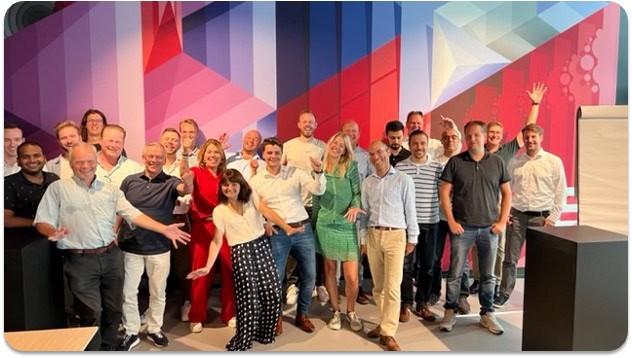
Differentiating Customer Experience with a Centralized App Ecosystem
Belgium’s leading telecom provider adopts Mendix to evolve their customer engagement in a native mobile application that supports business transformation. figmeta

Proximus is a leading provider of digital services and communication in Belgium, connecting over 3 million customers through internet, television, and mobile phone services.
With a slew of business-critical initiatives on the horizon and competitive pressure from new market entrants, Proximus needed to rethink their customer experience and quickly bring its next iteration to market.
However, a landscape of disparate customer-facing solutions for activities such as account management or video streaming meant a disjointed experience for Proximus’s customers. Additionally, legacy systems, technical debt, and slow development cycles made it a challenge to provide the modern media experiences that their customers expected.
In 2022, Proximus adopted the Mendix low-code platform to centralize their digital services in a modern entrypoint for customers called Proximus+. To ensure their success and future-readiness, Proximus also leveraged Mendix digital transformation best practices to change the way they release solutions going forward.
Aligning Business and Technical Aspirations
In recent years Proximus has expanded their digital services for customers with solutions such as Doktr, a telehealth application, and Pick X, a video streaming app. These new offerings were driven by the organization’s ‘Think Possible’ strategy, instituted by CEO Guillame Boutin in 2019.
This strategy has pushed Proximus to “engage with customers in new ways and be a driver in digitizing Belgian society,” said Georgi van Droogenbroeck, product owner for Consumer Strategy and Digital Ecosystems.
These solutions have supported Proximus in maintaining their premium positioning in the market. However, each of the applications existed independently, meaning that a Proximus customer would need to download multiple applications and use separate logins to engage with their services.
“We have a very broad landscape of applications with six customer-facing apps in the market. Putting marketing costs behind each of those applications becomes a lot of stories to tell and costly customer acquisition for each solution,” said Van Droogenbroeck.
Proximus had a vision to bring their application ecosystem together in a “Super App” that would unify their many customer-facing services.
With an executive mandate to find the most resource-efficient means of development, the Proximus team soon realized that a low-code platform could satisfy their technical requirements within a timeline and cost that was acceptable for their stakeholders.
Low-Code Offers High Adaptability
In 2021 Proximus conducted an evaluation of low-code market leaders to find a platform that could bring together six React Native-built applications into a single user interface. Van Droogenbroeck touts the Mendix Platform’s architecture and mobile capabilities as the leading technical differentiators in their selection.
“First, the platform offers branching capabilities. Additionally, Mendix native mobile runs on React Native which allows us to develop custom widgets. We have a lot of custom requirements, so the flexibility of reusing React Native and extending our core skillsets that we already had in-house was a huge benefit,” said Van Droogenbroeck.
Leaders at Proximus also saw alignment between the Mendix platform and their business strategy to become:
- More agile, as Mendix development goes hand-in-hand with the collaborative, iterative nature of Agile development, which had become increasingly popular within Proximus.
- More flexible and adaptable, supporting Proximus’ desire to create an ecosystem of reusable and composable app functionality, design, security, and architecture.
With a robust, all-in-one development platform and the process-driven expertise of Mendix, the Proximus team began development of their new super app, Proximus+, in March 2022.
Empowering New Ways of Working
The adoption of Mendix coincided with the launch of Proximus’ Peak Program, a strategy to shift the entire organization towards agile work.
“The Peak Program brought the implementation of multi-disciplinary teams working in the agile methodology,” said Van Droogenbroeck.
That facilitation can be seen in the visual, abstracted nature of Mendix low-code development. Van Droogenbroeck says that having the ability to “demo the logic and explain what is under the hood in a way that is understandable for stakeholders,” is a welcomed change from trying to present traditional code to a room full of businesspeople.
Ultimately, this allows the team to have a more meaningful dialogue about the progress of the application. Despite Mendix solving for traditional development missteps, there were still team members who were reluctant to change.
“There was a lot of change management needed to convince certain groups that low-code was the right path forward,” said Van Droogenbroek. “It’s like this with any transition of code, and we had the same experience when we introduced React Native.”
While there was no silver bullet to make human beings more change-adept overnight Proximus followed methods found in the Mendix Digital Execution Practice, which focuses on cross-functional collaboration and adopting an agile mindset.
Some tactics Proximus leveraged include:
- Promoting the progress of their work to the entire organization during Proximus+ days, where colleagues would speak about the project and provide sneak peeks of what was coming.
- Collaborating closely with Mendix R&D, allowing team members to discuss the platform’s boundaries and roadmap with experts.
- Bringing team members together to celebrate success and milestones during the development of Proximus+ as a team.

Van Droogenbroeck highlighted the benefits of adopting a change-ready mindset: “On the other hand, the people who embraced Mendix and agile saw how quickly they could make advancements. They also really embraced the concept of reusability and started to think in a more solution-oriented way.”
Today there are over 40 Proximus employees on the cross-functional teams using Mendix who come from a range of backgrounds.
“When we look at talent profiles to fill out the team, experience using Mendix is of course important. But I also think that, with the right inputs, any developer can quickly learn the technology… Our teams are evolving from pure IT to more cross-functional,” said Van Droogenbroeck.
One App to Rule Them All
Development of Proximus+ was completed in March of 2024, bringing six existing React Native applications into a single native mobile UX. Proximus’ design experts like Laura Versteele were critical in the early customer research and positioning that justified the unification of their services in Proximus+.
“When we crafted the value proposition for Proximus+ we thought through all the benefits for our customers. Many people mentioned that having so many different applications would lead to storage issues on their phone,” said Versteele.
Proximus+ launched as an upgrade to the existing MyProximus app where customers can now engage with digital services such as:
![]() Accessing their Proximus account to pay bills and manage plan information, data usage, and devices.
Accessing their Proximus account to pay bills and manage plan information, data usage, and devices.- Connecting with their community through a service called Neighborhood, where customers can network with their neighbors and share recommendations or events.
- Mobility services where customers can purchase train tickets, check transportation schedules, or pay for parking.
“It’s a daily companion in your pocket,” said Van Droogenbroeck, “We’ve aimed to take the most relevant aspects of daily life and bring them together in one application with one login.”
The Proximus team took a thoughtful and structured approach to crafting this new user experience, working in a ‘Double Diamond’ framework.
“Through our qualitative and quantitative research with users there were a few design principles we wanted to respect. First, we feature our telecom offering most prominently on the Proximus+ home screen so that it’s very clear that you’re in a Proximus application,” said Versteele.
“On the other hand, we make it very easy for users to discover the additional value-add services around mobility, home, energy, and neighborhood services.”

Versteele shared that striking a balance in design makes it easier for users to explore new services that are relevant for them, increasing Proximus’ awareness for additional services and partners.
“So far, we’re seeing that this approach has clearly satisfied a need, as we’ve seen a measurable impact on the time to develop and launch new features, while also onboarding external partners to the app ecosystem,” he shared.
A Future-Ready ‘Super App’ Ecosystem
The implications of developing Proximus+ with low-code were not just to address the present, but also having the flexibility to evolve in the future.
Of the architectural considerations for Proximus+, Project Manager Ben Sodermans said, “We’ve built an architecture that works very well for adaptability. We have the single app where our users enter, but you have a separate app for the different ecosystem features like mobility or home.
Low-code also expedites delivery by enabling Proximus to craft its own ecosystem of reusable integrations and functionality between applications when needed in a governed way.
“For me, one of the key benefits of low-code is reusability,” said Van Droogenbroeck. “We’ve prioritized establishing common components in our design systems. For example, we recently made bar charts for you telephone bill to show data usage that can also be reused where people want to see their energy consumption.”
“We can better balance instances that require custom designs versus opportunities for reuse, and how that impacts time to market. That is not something you can do with traditional coding,” he said.
The Mendix platform’s ease of integration, ecosystem of reusable components, and governance controls allows Proximus to scale out their own platform capabilities within predetermined guardrails.
The team has already tested their ability to expand into new business and service areas efficiently in the first iteration of Proximus+. “One good example is energy consumption,” said Sodermans.
“Our customers are looking for advice on how to reduce their energy consumption at home and compare prices, so we’ve developed an offering around that and we’ll continue to expand it… We have implemented real-time energy monitoring with suggestions, analysis, and notifications for the user to reduce their consumption and costs.”
Of their strategy moving forward, Tina Hernalsteen, Ecosystem Lead at Proximus, said, “As we mature the Proximus+ offering, we want to shift from a pure application to a platform approach that is also a place to connect our customers and partners. For instance, partners that our customers also opt to engage with can send out notifications via the Proximus+ application.”
Ensuring Ongoing Transformation
For Proximus centralizing their customer experience isn’t just beneficial for end-users, but over time they can better leverage user data to identify areas for cross-promotion of services.
Beyond the success of their first major project with Mendix, the Proximus team is already optimistic to realize more benefits of closing the business and IT gap in development, with a foundation laid through the Mendix Digital Execution Practice.
“The biggest change I’ve witnessed now that we’re developing in Mendix is the motivation and cooperation between teams,” said Sodermans. “People are happy working together towards a common goal on projects that are visible and valuable. Mendix also offers us the ability to prototype and test ideas and iterate more quickly towards the right outcome.”
This close collaboration is already sparking new ideas – of which the team has plenty related to their in-store experience, sales agent tools, and loyalty programs.
“The reusability, time to market, and cost efficiency are directly impacting how we evolve our customer experience and our business. We’re pleasantly surprised with the results we’ve seen so far.”
 Accessing their Proximus account to pay bills and manage plan information, data usage, and devices.
Accessing their Proximus account to pay bills and manage plan information, data usage, and devices.